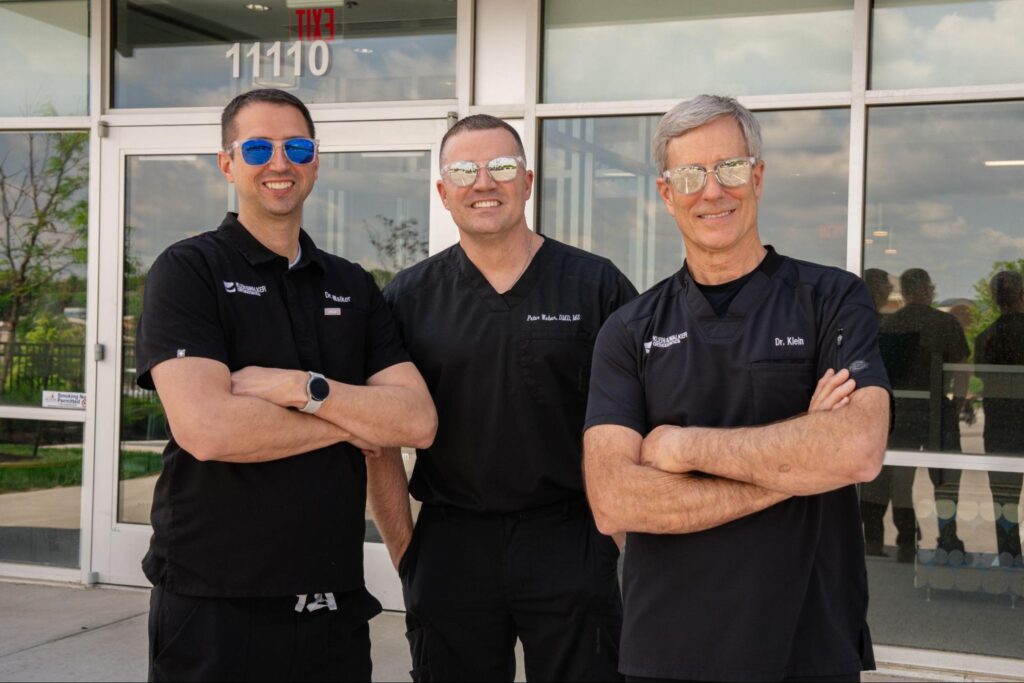When most people think of orthodontics, they picture straight front teeth and a confident smile. But orthodontists know that a truly healthy bite goes beyond the front of your mouth—it involves every tooth, all the way back to your second molars. At Klein & Walker Orthodontics, Dr. Michael Klein, Dr. Cameron Walker, and Dr. Peter Weber take a comprehensive approach to treatment, ensuring your second molars are properly aligned for function, comfort, and long-term oral health.
For patients in Olathe, West Olathe, and Overland Park, this focus means more than just cosmetic improvement. Correct second molar alignment supports efficient chewing, protects jaw joints, and keeps your smile healthy for years to come.
The Role of Second Molars in Your Bite
Your second molars—sometimes called “12-year molars”—erupt behind your first molars and are essential for balanced chewing and jaw alignment.
How Second Molars Contribute to Function
Second molars help you grind and break down food effectively, making them vital for digestion and daily comfort. If they’re misaligned, you may experience uneven wear on your teeth or difficulty chewing certain foods. Over time, these problems can lead to enamel loss, tooth sensitivity, and even TMJ (temporomandibular joint) discomfort.
Connection to Overall Bite Stability
Even if your front teeth look perfect, misaligned second molars can compromise your bite. When your bite is unstable, teeth may shift over time, undoing some of the results of your orthodontic treatment. Addressing second molars means that your smile stays in place long after braces or clear aligners, such as Invisalign or 3M Clarity, are complete.
For many patients, second molars erupt during the teen years—often in the middle or toward the end of orthodontic treatment. Monitoring their position and guiding their eruption is an important part of achieving a stable, well-balanced bite.
Orthodontic Strategies for Aligning Second Molars
Aligning second molars can be more complex than moving front teeth, but with the right approach, orthodontists can create both functional and aesthetic harmony.
Comprehensive Treatment Planning
At Klein & Walker Orthodontics, treatment starts with a complete set of diagnostic records, including X-rays, digital scans, and photographs. These images give Dr. Klein, Dr. Walker, and Dr. Weber a full view of your dental arches, roots, and jaw alignment, allowing them to design a plan that accounts for second molars from the beginning.
Using Braces to Guide Molars
Braces are particularly effective for aligning molars because brackets and wires can deliver controlled, consistent force to move these larger teeth. Sometimes, specific archwires or auxiliary appliances are used to fine-tune molar positioning without affecting the alignment of other teeth.
Clear Aligners and Molar Movement
Clear aligners can also address second molars, though the process may involve additional aligners or attachments to achieve the necessary force. Patients in Olathe, West Olathe, and Overland Park benefit from customized aligner plans that ensure molar movement happens alongside other tooth corrections.
Challenges with Second Molar Alignment
Second molars present unique challenges during orthodontic treatment due to their size, position, and timing of eruption.
Limited Space in the Arch
If the jaw doesn’t have enough room for second molars to erupt properly, they may come in rotated, tipped, or partially impacted. Orthodontists may need to create space using braces or aligners before these teeth can be moved into their correct position.
Late Eruption and Treatment Timing
Because second molars often appear later in adolescence, their eruption may overlap with the final stages of treatment. Orthodontists closely monitor eruption patterns and may adjust timelines to ensure these teeth are included in the final bite alignment.
Patient Comfort and Access
Second molars are harder to reach, both for orthodontic adjustments and for patients keeping them clean. Education on proper brushing and flossing techniques is critical to prevent decay around these back teeth during treatment.
Long-Term Benefits of Including Second Molars in Treatment
The payoff for focusing on second molars extends well beyond the end of your active orthodontic phase. Check out some of these important benefits of taking the initiative to care for your second molars with trusted orthodontists like Dr. Klein, Dr. Walker, or Dr. Weber.
Reduced Risk of Relapse
When all teeth, including the second molars, are properly aligned, the bite is more stable. This stability helps prevent shifting after braces or aligners, meaning your results last longer.
Improved Chewing Efficiency
A bite that includes well-aligned second molars distributes chewing forces evenly, reducing stress on any one tooth and supporting long-term tooth and jaw health.
Better Oral Health Outcomes
Proper alignment makes it easier to clean around second molars, lowering the risk of cavities, gum disease, and plaque buildup. Over the years, this can help you maintain a healthy, functional smile.
How Retention Protects Second Molar Alignment
Completing orthodontic treatment is an exciting milestone, but keeping your second molars in place requires a strong retention plan.
The Role of Retainers in Molar Stability
Retainers aren’t just for keeping your front teeth straight—they help maintain alignment across your entire bite. When worn as directed, retainers ensure second molars stay in their corrected position, preventing subtle shifts that could affect chewing efficiency and bite comfort.
Types of Retainers for Full-Arch Support
For many patients in Olathe, West Olathe, and Overland Park, a custom retainer that covers the full arch is the best choice. This design keeps pressure balanced and holds every tooth, including second molars, in place. Our orthodontists tailor each retainer to your unique bite for maximum stability.
Long-Term Care for Lasting Results
Like any part of your smile, second molars need ongoing attention. Regular checkups at Klein & Walker Orthodontics allow us to monitor your bite, adjust retainers if needed, and keep your teeth—and the investment you made in them—healthy for years to come.
Second Molars: A Small Detail with a Big Impact
Orthodontic treatment is about more than just straightening the teeth you see when you smile. By giving second molars the attention they deserve, orthodontists create results that look great and function even better.
If you’re interested in learning more about second molars in orthodontics or want to know how they fit into your treatment plan, schedule a free consultation with Klein & Walker Orthodontics. Dr. Michael Klein, Dr. Cameron Walker, and Dr. Peter Weber proudly serve patients in Olathe, West Olathe, and Overland Park with treatment plans that address every detail of your smile.






